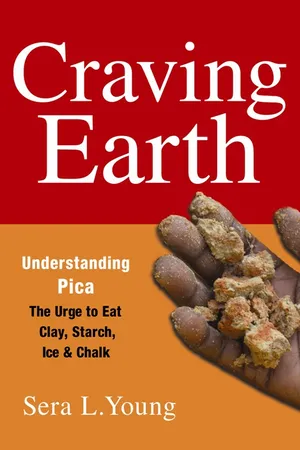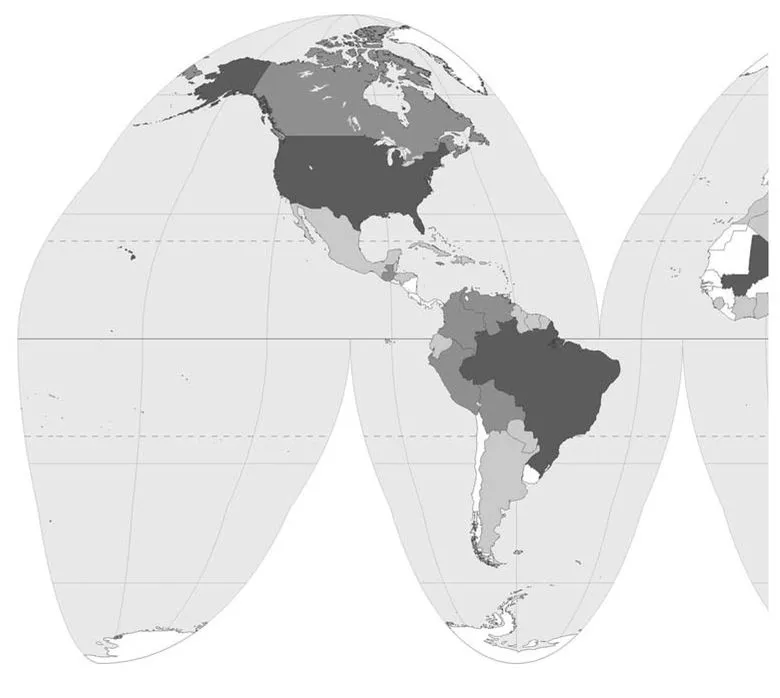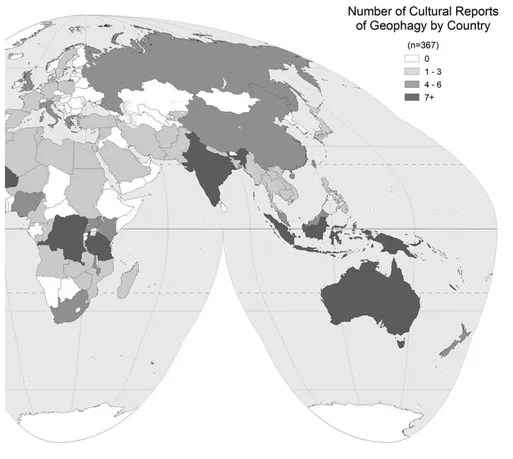![]()
PART ONE
All About Pica
dp n="19" folio="" ?dp n="20" folio="" ? ![]()
CHAPTER ONE
What on Earth?
MAMA SHARIFA eats chunks from the earthen wall of her outdoor kitchen in Zanzibar, while in Washington, D.C., Pat crunches through a ten-pound bag of ice from 7-Eleven every day. In New Delhi, Simran starts her morning with a handful of uncooked rice, and in Mississippi, Tanya eats Argo cornstarch, but only after her husband has gone to work. In Guatemala, Carlita nibbles little blocks of clay with a Virgin Mary pressed into them, while in California, D’angela buys ten boxes of chalkboard chalk for snacking whenever she can get to a Walmart. What is the common denominator? These are all instances of pica (see Glossary).
Pica is the scientific term for the craving and subsequent consumption of non-food items.1It’s not an acronym, or an abbreviation, or a famous physician’s last name. Pica pica is the genus and species of the common magpie (fig. 1.1). Magpies are frequently seen with all sorts of items in their beaks, from chewing gum wrappers to wire hangers. Because of their attraction to sparkly objects, they were thought to be birds with an indiscriminate appetite. (As it turns out, they don’t swallow these items; they build their nests with them.) By analogy, the human condition of desiring non-food items was given the name “pica” in the sixth century (Aetius of Amida/Ricci 1542 [1950]:20). I use the term pica to mean the craving and purposive consumption of items that the consumer does not consider to be food for more than a month (Young 2010).
FIGURE 1.1
The magpie, Pica pica. Drawing by Wilhelm von Wright (1810–1887), from Svenska fåglar, efter naturen och på sten ridade (see http://commons.wikipedia.org/wiki/File:Pica_pica).
Pica is not the only name for this behavior, however. Eating non-food items has been referred to in many ways in the two thousand years that people have been writing about it. Some terms are very arcane. Citta, for example, is a term that Galen used for pica; it is Greek for ivy, but may be a misspelling of kitta, which is Greek for magpie or jay (Weiss-Amer 1993). Other general terms that have been used as synonyms for pica include cachexia (Liebault 1598), cachexia Africana (Chisholm 1799), chthonophagia (Dors [Dons] 1838), hapsicoria (Motherby 1785), mal d’estomac (Thibault de Chanvalon 1761), malacia (Liebault 1598), and paroroexia (Ruddock 1924).
Pica is a general term, and in modern medical literature eating non-food items is frequently referred to in more specific ways. Names for specific types of pica generally have Greek origins. They combine the names of specific substances, e.g., “geo” (earth), “amylon” (starch), and “pagos” (ice), with “phagein” (to eat), thus yielding geophagy,2 amylophagy, and pagophagy (Coltman 1969).3
dp n="22" folio="5" ?
The Pica Substances
Earth is the most commonly craved substance, but it is far from the only one. In fact, the list of pica substances is very long. In roughly descending order of frequency, it also includes cornstarch, ice (if consumed in large quantities), chalk, charcoal, ash, flour, newspaper, toilet paper, used coffee grounds, baby powder, and paint chips. While this list may seem highly heterogeneous, there is one commonality. With the exception of ice, all of these substances are dry, powdery, and adsorptive (see adsorption), and most of them are rather crunchy.
Just as we now know that the magpie’s appetite is not indiscriminant—those non-food items in their beaks are housing materials, not lunch—pica cravings are not indiscriminant, either. People regularly go out of their way to obtain items that have the precise odor, texture, and taste they desire, as you’ll see in the following descriptions of the three most frequently craved pica substances.
Earth (geophagy)
Humans have been consuming earth for a very long time. There is good evidence to suggest that we were even eating it two million years ago, when we Homo sapiens were still Homo habilis (Clark 2001:659–62; see also Appendix A, this volume).4 Earth is consumed in many forms and comes from many sources including mud from a riverbed, broken bits of pottery, earth clods found among dry pinto beans. The amount consumed daily varies, but quantities of 20–40 g are typically reported (Geissler et al. 1997; Luoba et al. 2005; Saathoff et al. 2002; Young et al. 2010b), Most of the earth consumed is rich in clay (Young 2010); although clays may seem unremarkable, they have amazing properties that are discussed at length in chapter 3.
But not just any earth will do. People go to extreme lengths to obtain the earth of their heart’s desire. They may be secretive about the whereabouts of their clay pit (Silverman and Perkens 1966), walk many miles to the site with “good dirt” (Dickens and Ford 1942), tussle with the cattle who are also eating “their” clay (Hunter 1993), and implore relatives to mail boxes of clay when they move to a place with unappetizing soil (1967; Dickens and Ford 1942; Frate 1984). The smoothest soils (i.e., those high in clay content) are the most sought after, from the Arctic (Richardson 1851:191) to the Amazon (von Humboldt et al. 1821, pt. 2, pp. 639–64), and everywhere in between. Sandy soils and soils high in dark organic material, called humus, are typically avoided.
The smell of earth is an important criterion for soil selection the world over over (e.g., Forsyth and Benoit 1989; Hooper and Mann 1906; McIntyre 2000). The earth’s scent after rain, called petrichor (Bear and Thomas 1964), is a particularly important indicator of its suitability.5 During ethnographic interviews, women’s mouths would literally water as they described to me the appealing smell of freshly moistened earth.
Another criterion for geophagists is that their dirt be “clean.” Most earth for consumption is collected from places where animals do not tread (and therefore cannot defecate), such as from areas high up on a wall or the interior of a well; others insure the hygiene of their earth by drying and/or heating it, either in the sun or over open flame (Young et al. 2007).
One of the stories that best illustrates the acuity of geophagists’ selectivity involves a geophagic wife, a devoted husband anxious to avoid trouble, and police surveillance in Memphis, Tennessee (Finger 1993). The wife sent her husband to get her some clay from her favorite riverbank. She did not want to go because police had been staking out the site, suspicious of the many small holes dug into the bank. But she just had to have some. He dutifully left the house and returned with a bag of earth for her. When she opened it, she knew immediately that it was not from her favorite riverbank spot. She sent him right back out for earth from the stakeout riverbank.
Earth-eating is far more common than just a few cases here and there. Estimates range from <0.01% among pregnant Danish women (Mikkelsen et al. 2006), to 5.2% among pregnant Pembans, to 56% among pregnant women in coastal Kenya (Geissler et al. 1998b); Appendices B and C summarize studies of the prevalence of different types of pica among representative samples of pregnant women and children, respectively.
Commoditization is a great indicator of demand, and yes, geophagic earth is now for sale. In fact, there is enough demand across the United States that Sam’s General Store, a shop in White Plains, Georgia, that sells geophagic earth, has established an online presence (http://whitedirt.samsbiz.com/). They sell earth in two-pound increments, marked as “a novelty item” (probably to avoid any lawsuits). And just in case you are worried about what the postman may think, their deliveries arrive discretely in unmarked cardboard boxes.
Sam’s General Store sells kaolin, which many geophagists consider to be the most desirable type of clay. However, there are many types of earth eaten, and almost as many names for it. For example, on Pemba Island, where I first learned about geophagy, people eat four types of earth. Their Swahili names are udongo, ufue, vitango pepeta (also known as vitango mlima) and mchanga. In other places, the variety of geophagic soils is even greater (e.g., Vermeer 1971).
And where does geophagy happen? We know for sure that it occurs on all six inhabited continents (Hooper and Mann 1906). Our best information about the worldwide distribution of geophagy comes from ethnographic literature, i.e., reports from anthropologists, missionaries, and explorers. I have assimilated data from 367 such reports of geophagy, and it is clearly ubiquitous (fig. 1.2). The methods for this analysis are described in chapter 2. The worldwide distribution of pica is discussed in greater detail in chapter 9.
Raw Starch (amylophagy)
These days, it’s easy to think of starches as a food group to avoid, thanks to the demonization of carbohydrates by the infamous Atkins diet. But take a look at any USDA food pyramid and you’ll see that starches—rice, pasta, breads, and tortillas—ought to provide the bulk of our calories. Uncooked starches, too, have a place in our daily lives, although they have little to offer us calorically.6 Even so, they play a role in our cuisine. They thicken Thanksgiving gravies, give lightness to Christmas shortbread, and prevent powdered sugar from caking.
Raw starches have another function, one that is germane to pica: they sate extraordinarily strong cravings. Until a few decades ago, raw starch was available in most grocery stores in two different products, both of which were attractive to amylophagists. There was cornstarch, mostly used for thickening foods, and there was laundry starch. In the 1960s, before the convenience of spray starch and the magic of wrinkle-free fabrics, if you wanted unwrinkled shirts you needed laundry starch. Back then, laundry starch, which can be made from corn, wheat, or rice starches, was sold in big chunks. When it came time to do the starching, these chunks would be dissolved in warm water, laundered clothes would be dipped into the solution and, once dry, they would be ironed. Besides nicely crisping your collars, it was handy for preventing stains: daily grime would bind to the starch rather than to the fibers of the cloth, making it easy to rinse out.
Many women seeking substitutes for earth that is no longer available have turned to starch as a replacement (e.g., Associated Press 1988; Hertz 1947; McIntyre 2000; Vermeer and Frate 1975). This was particularly common in the mid-1900s among black women who moved from the southern United States to industrial areas like Chicago and Detroit, where the earth they desired was not available. A photograph of a Washington, D.C., resident, in which she and her giggling young son pop chunks of starch in their mouths, appeared in a 1967 Time magazine with the caption: “As good as clay any day.”7 (Even Argo’s cornstarch packaging suggests how its starch may be substituted for clay, albeit not for human consumption. On the outside of some Argo starch packages, there is a recipe for “Play Clay” in which Argo is the main ingredient.)
FIGURE 1.2
Distribution of 367 ethnographic reports of geophagy, by country (based on the Pica Literature Database). Map created by Geographical Techniques (www.geotechmap.com).
dp n="26" folio="9" ? For many women, though, starch is not a mere substitute; it is the most desirable substance. An enormous variety of raw starches are craved and consumed around the world, including uncooked rice (Giudicelli and Combes 1992; Kettaneh et al. 2005; Posner et al. 1957; Roselle 1970; Young et al. 2010a), wheat, cassava, and rice flours (Kraemer 2002; Levacher 1840; Ward and Kutner 1999), and raw starchy vegetables (tubers) including potatoes and cassava (Johnson and Stephens 1982; Libnoch 1984). However, at least in the United States, cornstarch once reigned over them all.
dp n="27" folio="10" ?That reign has been curtailed, due in large part to the untiring efforts of Dr. Gerald Deas. Dr. Deas is an animated, hands-on physician who still makes house calls and cares seriously about public health: think Cliff Huxtible meets Florence Nightingale. In the 1960s, when he was interning in a Brooklyn obstetrics clinic, he noticed that a lot of black women, “maybe 99 percent,” were eating starch (Cleaton 1983; Day 2000). Dr. Deas explained to me that “in those days, starch was typically stocked in the snack aisle of the grocery store, along with cookies and candy.” He, like many, believed that eating starch caused iron deficiency, and so felt compelled to reduce its prevalence. He was also concerned about the weight gain associated with eating large quantities of starch: one box of cornstarch contains 1,680 Calories, and some women eat as many as three boxes in a day.8
So, Dr. Deas became a one-man campaign to educate women about the dangers of starch-eating. He helped to produce pamphlets with catchy, community-friendly slogans that were distributed by the National Urban League: “If you eat laundry starch, you’ll become a stiff”; “Eating laundry starch from a box is as nutritious as eating rocks”; and “The main thing is what is that package of starch doing to your package [fetus]?” He wrote columns in local newspapers and appeared on radio shows and news broadcasts to discuss the dangers of starch-eating.
His public-awareness campaign efforts paid off tangibly in the reform of the packaging and marketing of starch (fig. 1.3). In 1977 the director of public relations at Best Foods (which produces Argo starch) sent him a letter stating that “the next order of their packaging material will have ‘Not recommended for food use’ prominently displayed on the front panel.” Several years late...




